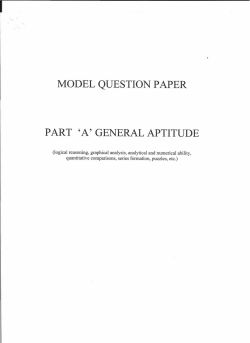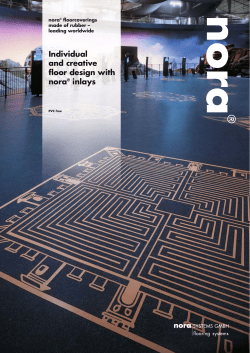
International Journal of Innovative Technology and Exploring Engineering (IJITEE)
International Journal of Innovative Technology and Exploring Engineering (IJITEE) ISSN: 2278-3075, Volume-2, Issue-2, January 2013 The Mathematical Aspects in Art to Create Decorative Effect in Design Patterns Kulwant Singh, Atul Kumar, Nitin Sharma the decorative design art which helps in representing the design patterns in the terms of mathematics. These parameters can be used further for introducing digital concept in the handicraft work and can proceed toward automation. Abstract— Mathematics is not just about formulas and logic; instead it can be used to express beauty and shapes through patterns, symmetry and arrangements. With the assistance of mathematics, artists can achieve new heights in the field of designing. The linkage between design art and Mathematics provides the background to this work. The work involves the art and style shaped in the handicraft sector, in which the designs are originated in the geometric aesthetic. This work pivots on how the mathematics, algorithms and technology have been applied to produce traditional design patterns in the sense of artist. Keywords — Art, Motif, Pattern, Symmetry. II. LITERATURE By using the field of computer graphics, a lot of researches have taken place to produce a computer-generated decorative pattern which offers many algorithmic possibilities for creating two-dimensional decorative effects. A. van der Zee[1] presented Generative Design in a historical context. The Generative Design and briefly discuss the most important mathematical methods that have been developed, that are relevant with regard to shape generation. Chua [2] described a method for generating parametric patterns aligned along a circular arc. Kaplan [3] presented a process for creating computer-generated Islamic star patterns. C.S. Wang [4] presents the effective method of digitizing Chinese Calligraphy font using CAD software. Ronald Strebelow [5] develop continuous-time Markov chain models of two commonly used design patterns. Gulati [6] developed a parametric CAD modeler for creating star patterns to produce traditional piece of lattice-worked screens. Trivadi [7] presented an application of CAD for producing Moradabad brassware patterns. Wong [8] described and explored the ways in which floral patterns can be created algorithmically. Kedar [9] proposed a design software for generating 2D floral border patterns. Anderson [10] created beautiful ornamental 2D patterns, which follows a user-defined curve. I. INTRODUCTION The tradition of exquisite decorative design patterns exhibits from the years in the history. The decorative design patterns are accepted in all applications of designing in the arts belongs to different places. The design are not only restricted to domestic use, but also extended to the fashioning of screens, cabinets, doors, windows, temples and furniture. All design schemes/patterns are identify and famous, for its uniqueness, attractiveness, meticulousness. Till now, the designer starts their innovative ideas of creativity in their profession of design with the help of paper and pencil that is passed on through generations. Due to its complex traditional designing and production with hand, many problems are arising on the future of such art form. Among the most important aspects of geometric design are repetition and variation. A series of tiles, for example, may consist of only one or two shapes but the patterns of the tiles may all be different. In other designs, a few different shapes may be combined to create a complex interlocking pattern. Symmetry plays a part in most patterns. There may be a single line of reflective symmetry, usually from the top to the bottom, or there may be three or four lines of symmetry. Straight (translation) and turning (rotational) movements are also used. Sometimes reflective symmetry and the two kinds of movement are found in the same design. Symmetry and repetition give unity to the more complex designs, as in this panel with a pattern based on pentagons. Most of the patterns in the design objects are based on the polygons i.e. triangle, square, rectangular, pentagon, hexagon etc. These can be made by using only a compass and a straightedge, and both can fit within a circle so that all points touch the circumference. Patterns based on triangles and hexagons are easy to make using a compass and straightedge because the radius of a circle divides its circumference into six equal parts. This paper presents the backgrounder mathematical part of III. GEOMETRICAL REPRESENTATION OF MOTIFS The use of geometry is important in the development of the style of designs, whatever forms it takes. Circles, for example, are essential in designing floral patterns. The use of purely geometric elements to create elaborate patterns, though, has become a complicated form of decoration on its own. The appeal of geometric decoration lies in its logical interrelation of parts, reflecting in abstract form the underlying order found in nature. In this work, the patterns are classified in three category according to geometrical construction of the motifs of designs. In first category, the motifs are constructed by the combination of circles, arcs and lines. Fig.- 1 shows the floral motifs of the designs which are initially geometrically constructed as: Manuscript received on January, 2013. Kulwant Singh, Mechanical Engineering Department, Saraf institute of Engineering & Technology, Hanumangarh,Rajasthan,India Prof. Atul Kumar, Computer Science & Engg Deptt, Saraf institute of Engineering & Technology, Hanumangarh,Rajasthan,India Nitin Sharma, Computer Science & Engg Deptt, Saraf institute of Engineering & Technology, Hanumangarh,Rajasthan,India. 36 The Mathematical Aspects In Art To Create Decorative Effect In Design Patterns and swing the pencil leg so that a mark is made on the circumference. Move the point of the compass to the pencil mark and make another pencil mark on the circumference. Continue doing this round the circle until there are six marks. From these six marks the series of hexagons and six-pointed stars illustrated here can be made. 1. Join up the points in sequence round the circle to make the six-sided polygon, a hexagon. This has three pairs of parallel lines 2. Next join up every second point. You now have an equilateral triangle 3. Join up the other three points and you have a second equilateral triangle. Together these two triangles make up a star. One triangle points up to heaven, the other points down to earth. Three pairs of parallel lines make up the star. In the middle of the star is another hexagon Now with the combination of lines we can create the different motifs as in Fig. - 4. Fig.-1 Geometry of Motif Let point O is the center point from which we draw two circles of radius r & R (r < R). Take any point A on the outer circle. Draw an arc from point A with radius R which gives point B on circumference of outer circle. Draw an arc of same radius from point A taking center point B which intersect the first arc at point C. Line OA and OB give points I and J on inner circle. Join the points AJ and BI. The rest of motif followed through application of symmetry group, which can be completed with construction given earlier. This geometrical design can produce the three motifs as shown in Fig.-2. Fig. - 4 Geometrical Design of Motifs (Category- II) And in the third category, the border/interlaced design motifs and other decorative motifs (Fig. -5) can be constructed with no more than counting squares. In such designs the innovative ideas of the designer proceed towards the new design motifs. The design of such motifs depends upon the creativity and practice of the designer. An array of lines in objective to constructing the squares provides a best platform for producing these motifs Fig.- 2 Geometrical Design of Motifs( Category- I) Draw three circles with radius r1, r2 & R taking point O is the center point. Let the OB is the reference line. Draw the line OD at an angle 2π/n from the reference line where n is the total no. of lines round the circle. Now find the center point E at the line BD and draw arc of radius EB or ED from B to D point. Now this same process will be repeated to construct the complete motif. Fig.-3 Design of Motif by Geometry In second category, the motifs based on triangles and hexagons are initially constructed with the help compass. Open the compass about two inches and press the point into the paper. This is the 'invisible' starting point from which the design will unfold. Draw a circle with the compass. Put the compass point anywhere on the circumference of the circle Fig.- 5 Geometrical Design of Motifs( Category- III) IV. MATHEMATICAL PHASE OF MOTIF 37 International Journal of Innovative Technology and Exploring Engineering (IJITEE) ISSN: 2278-3075, Volume-2, Issue-2, January 2013 GEOMETRY In this proposed work the mathematical concept plays a vital role to proceed towards automation. As prescribed in the geometrical section of the motifs, a motif/design can be easily drawn on paper with the help of pencil, compass and scale if algorithm is followed. All the points (i.e. point on the circle, intercepting point of two circle, intercepting point of line and circle etc.) are obtained in mathematical term by applying geometric rules. Petal Motif Pattern Fig.- 7 Pattern generated with three Hierarchical levels VI. CONCLUDING REMARKS This work establishes a convergence of decorative art design and technology. It is not only for use to show the decorative art but also indicate the way; that how traditional skills of design and technologies can be engaged. These digitalized design motifs can also be utilized for storage of design and for later use whenever required by artists/designers. In the area of digitizing cultural artifacts, designer also enabled be work on other traditional planar artworks, such as lattice screen work, ink art painting, stone carvings, paper cuttings, etc. This allows us actively to preserve culture of art and apply it in decorative design styles with a lot of variation. Fig. – 6 Geometrical Construction of a motif’s petal From Fig. -6, Taking Point O is (0,0), the radius of main circle is R and n is the total no. of petals in the motif round the circle. The angle between OA and OB is θ = Point B is (R,0) and Point A is (R Cosθ, R Sinθ) The radius of arc BC and AC is AB = 2R Sin Equation of circle I drawn with radius AB and from center point A is (X-R)2 + (Y)2 = 4r2 Sin2 Equation of circle II drawn with radius AB and from center point B is (X-R Cosθ)2 + (Y- R Sinθ)2 = 4r2 Sin2 The intersecting point of the circle I and II, C is obtained by equating the equations of both circles: = 2R Cos Sin ( )π, 2R Sin Sin ( )π Now all required points are obtained in the terms of two variables i.e. the radius of main circle and the no. of petals in the motifs. An algorithm for each motifs is prepared, design depends upon the value these variables. By varying the value of these variables designer can produce the motifs with a lot of variation. In this work, the motifs belongs from studied category are being parameterized in mathematical terms. These mathematical parameters are directly implemented under the ActiveX and VBA programming environment using AutoCAD. Fig.- 8 Contemporary Decorative Design Patterns REFERENCES [1] V. PATTERN GENERATION [2] The appeal of geometric decoration lies in its logical interrelation of motifs. Patterns are composed of motifs which are multiplied and ordered in regular sequences by using transformations between them. The role of transformations is to define positions of the motifs with respect to pattern in a 2D plane. Motifs are placed in a pattern with a special theme e.g. aligning motifs along a specified path or in a rectangular array (Fig.- 7). Different styles of fashionable patterns have been produced (Fig. - 8). [3] [4] [5] [6] 38 A. van der Zee, B. de Vries, ―Design by Computation‖ GA2008, 11th Generative Art Conference, pp 35-52 Chee Kai Chua, Robert Gay and Wolfgang Hoheisel , ―A Method of Generating Motifs Aligned Along a Circular Arc‖, Computer & Graphics, Vol. 18, No. 3, pp. 353-362, 1994. Kaplan C. S. ―Computer Graphics and Geometric Ornamental Design‖, Ph.D., University of Washington, Seattle, 2002. Wang, C. -S., Chang, T. -R., Hsiao, C. -Y. and Teng, C. -K.'Product development for Chinese calligraphy using reverse engineering and rapid prototyping', Virtual and Physical Prototyping, Vol. 1, No. 4, 259 — 269 Ronald Strebelow, Mirco Tribastoney, Christian Prehofer ―Performance Modeling of Design Patterns for Distributed Computation‖ Vishal Gulati, Puneet Tandon, Hari Singh, ―A CAD Paradigm to Produce Zillij Style of Geometrical Patterns for Wooden Carvings‖, International Journal of Computer Applications Vol. No.3, 2010. The Mathematical Aspects In Art To Create Decorative Effect In Design Patterns [7] Trivedi S., Tiwari A., Chatterjee A., Pathak V., Dhande S. G. and Chauhan D. S., ―Application of CAD, Rapid Prototyping and Reverse Engineering in Handicrafts Sector – A Success Story‖, 9th International Conference on Engineering Education, July 2006. [8] Michael T. Wong, Douglas E. Zongker and David H. Salesin, ―Computer-Generated Floral Ornament‖, University of Washington. [9] Kedar S. P.,‖ Geometric Modeling of Patterns‖, Master’s thesis, Department of Computer Science and Engineering, Indian Institute of Technology, Kanpur, India, 2009. [10] Dustin Robert Anderson, ―Two-dimensional Computer-generated Ornamentation Using a User-driven global planning strategy‖, Master of Science in Computer Science, Thesis, California Polytechnic State University, San Luis Obispo, 2007 [11] Vishal Gulati and Puneet Katyal,‖ A Hierarchic Representation Scheme For Generating Decorative Pattern‖s, International Journal of Current Research Vol. 3, Issue, 11, pp.186-189, October, 2011 39
© Copyright 2025

















